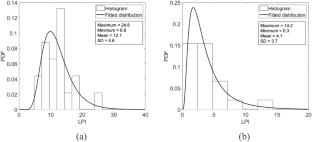Resonance compaction technique for liquefaction mitigation: CPTU liquefaction hazard indices and random field-based evaluation
Abstract
The resonance compaction technique (RCT) is a novel and effective method for improving deep liquefaction-susceptible layers. This study utilizes piezocone penetration test (CPTU) data integrated with random field models to quantitatively evaluate the effectiveness of RCT in mitigating liquefaction hazards. Four liquefaction indices, calculated both before and after the RCT, are used to quantify site improvements. A random field-based approach is developed to enable spatial interpolation and uncertainty quantification across the site. Comparisons among the four liquefaction indices provide insights into their effectiveness in representing the site’s improvement after RCT treatment. Results reveal that RCT, as a novel compaction technique, significantly reduces the liquefaction potential of the site and is particularly effective in reinforcing deep liquefaction-susceptible layers (over 15 m in depth). The effectiveness of the improvement can be visualized and quantitatively evaluated by the random field-based approach, demonstrating the significant value of the random field models for practical applications.


 求助内容:
求助内容: 应助结果提醒方式:
应助结果提醒方式:


